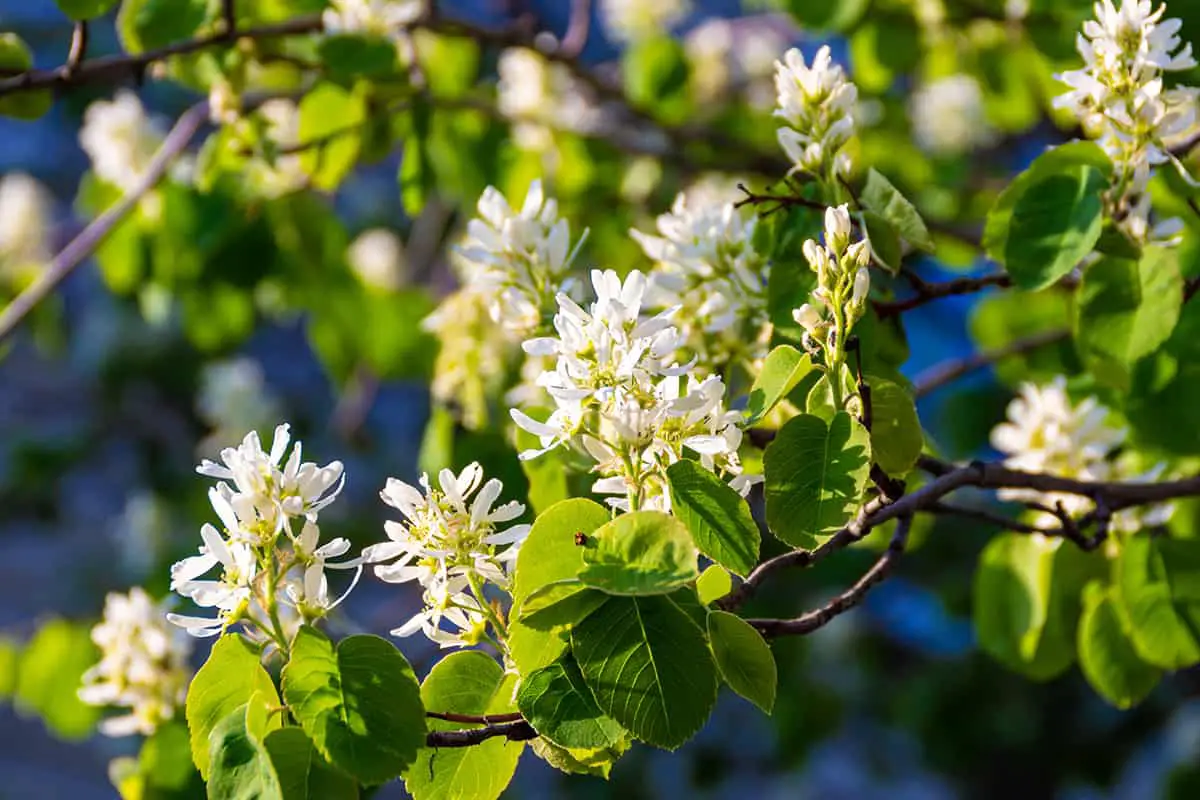Fragrant flowers are a wonderful addition to a sensory garden since they ignite our senses and add an extra layer of enjoyment to an outside space.
Here we explore a range of shrubs that produce white flowers with appealing scents.
Table of Contents
Glossy Abelia
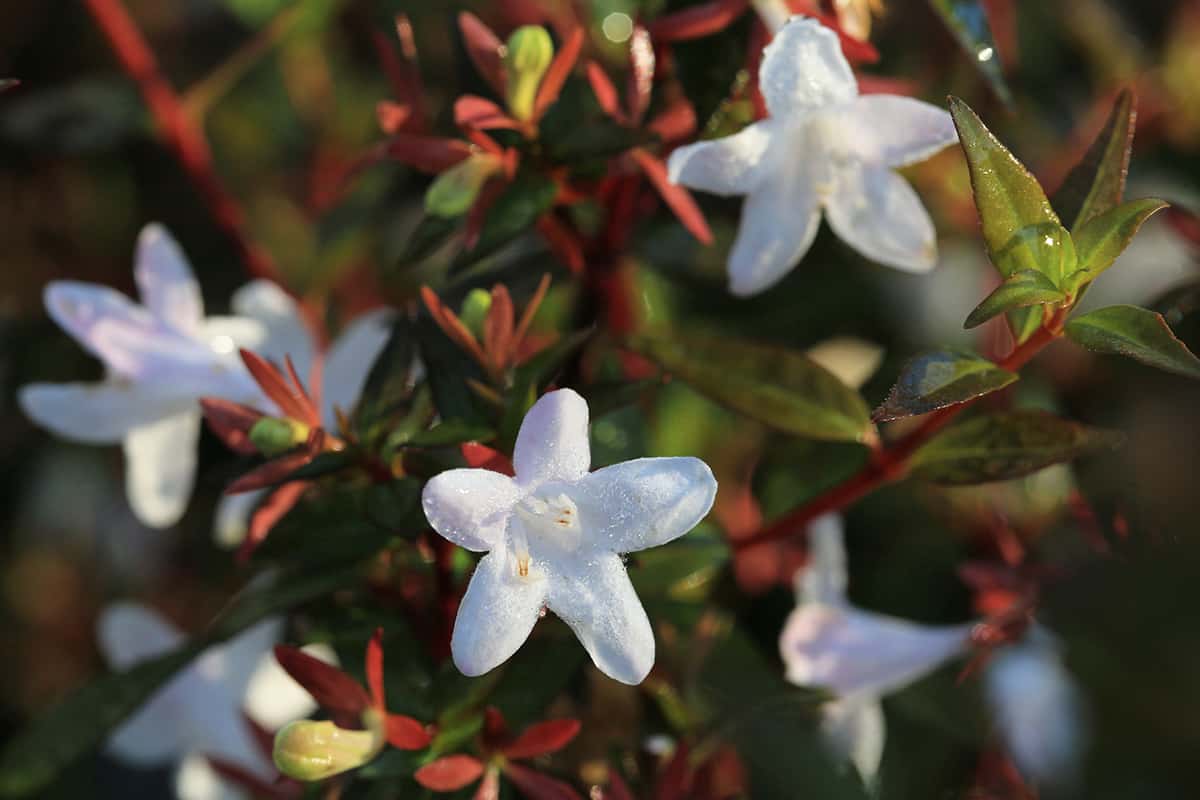
- Botanical name: Abelia × grandiflora
- Family: Caprifoliaceae
- USDA hardiness zones: 6 – 9
- Mature height: 3 to 6 feet
- Mature spread: 3 to 6 feet
This is a semi-evergreen shrub with a rounded habit, which grows to form medium-sized mounds of glossy, dark green foliage. It flowers for a long period of time, from the end of spring right through to fall. The blossoms are trumpet-shaped, and they arrive in clusters that dangle from the tips of arching branches.
The flowers have a delicate fragrance that smells similar to jasmine flowers. This shrub grows well in full sun or partial shade, though more flowers will be produced in full sun. It enjoys well-draining soils which are kept consistently moist but not wet. It works well for informal hedging, borders, or as a specimen plant.
Saskatoon Serviceberry
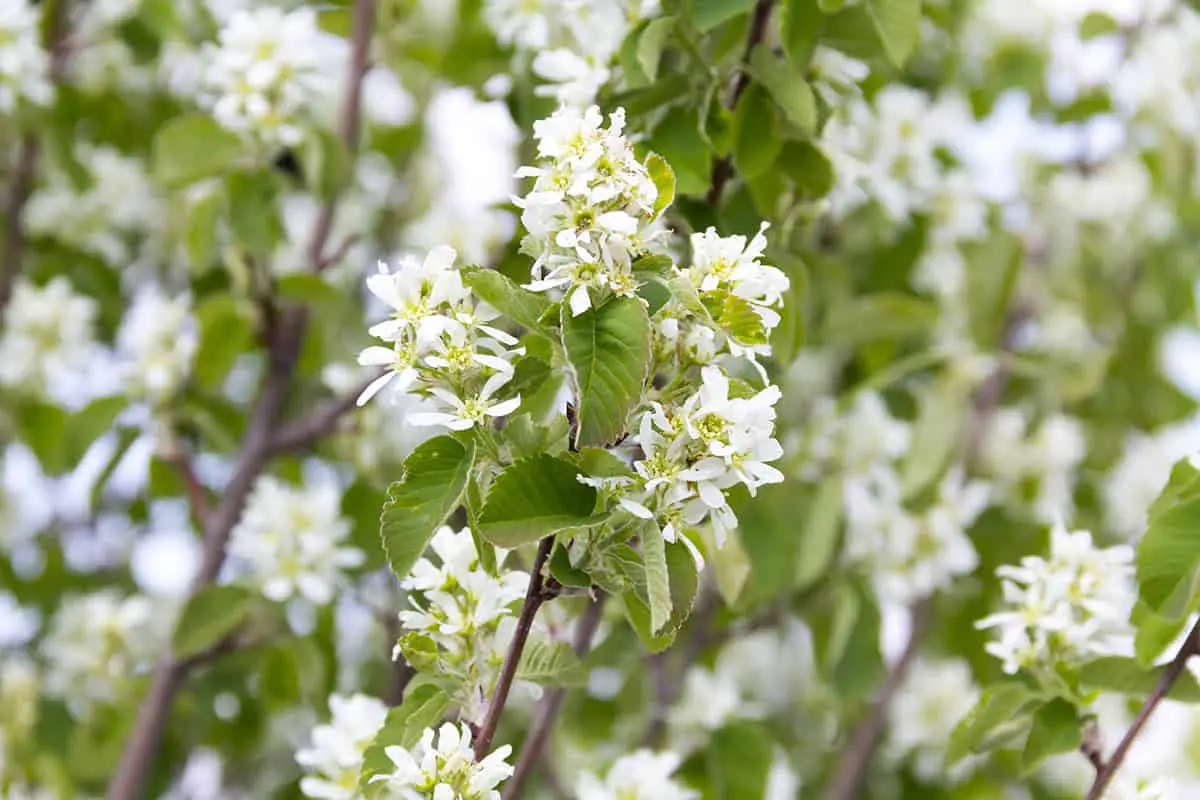
- Botanical name: Amelanchier alnifolia
- Family: Rosaceae
- USDA hardiness zones: 2 – 7
- Mature height: Up to 15 feet
- Mature spread:Up to 15 feet
Also known as the Western Serviceberry, this deciduous shrub is native to western Canada and some of the mountainous regions of the western United States. It has an upright habit and can also be grown as a multi-stemmed tree. In the middle of spring, dense clusters of flowers will bloom on the bare branches before the arrival of the foliage around a week later.
The flowers are small, white, and heavily fragrant. By early summer, the blooms will have been replaced by small berries in a dark shade of blue, which resemble blueberries. They add further visual interest to the shrub and are also great for making jams and jellies. In fall, the green leaves take on fiery red and orange shades before dropping to the ground.
This plant grows best in well-draining, moist soils and in full sun or partial shade. It is an attractive individual specimen but can also be trimmed into a hedge or privacy screen.
Angel’s Trumpet
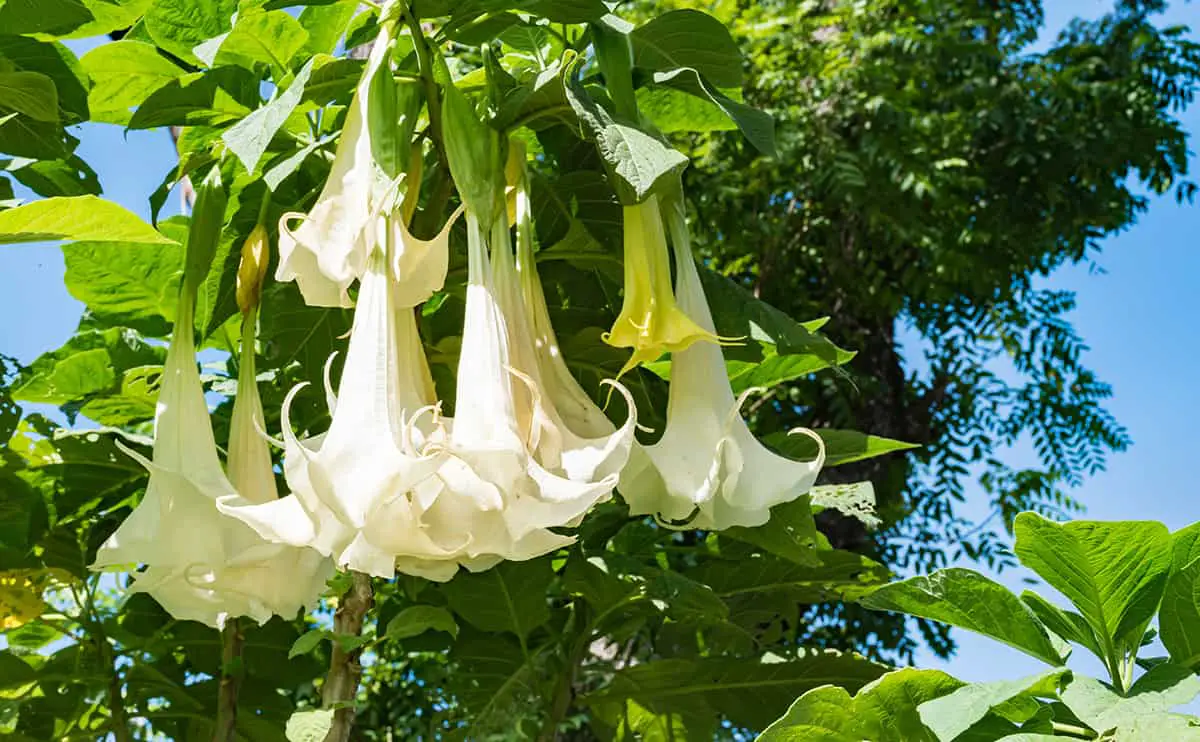
- Botanical name: Brugmansia suaveolens
- Family: Solanaceae
- USDA hardiness zones: 9 – 11
- Mature height: 3 to 8 feet
- Mature spread: 2 to 4 feet
This plant goes by several common names, including Angel’s Tears, Snowy Angel’s Trumpet, and Brazil’s White Angel Trumpet. It is native to Brazil but is unfortunately believed to be extinct in the wild in this area. It is, however, widely cultivated as an ornamental shrub and has received the Award of Garden Merit from the Royal Horticultural Society.
It has also become naturalized in other parts of the world, including Australia, and is actually considered to be an invasive weed in some regions. The Angel’s Trumpet produces enormous pendulous flowers which measure around 12 inches long and flare out at the bottom in a trumpet shape.
They are pure white and give off a strong scent that is at its most potent during the evening. Grow this shrub next to an outdoor dining area so the aroma can be enjoyed over dinner or evening drinks. The plant will remain in flower from the middle of summer through to fall against a backdrop of bright green foliage.
Snowy Angel’s Trumpet performs best in full sun but can tolerate some shade in especially hot climates. It relies heavily on nutrients to produce an abundance of flowers, so add organic content to the soil and use a frequent fertilizer.
Lemon Bottlebrush
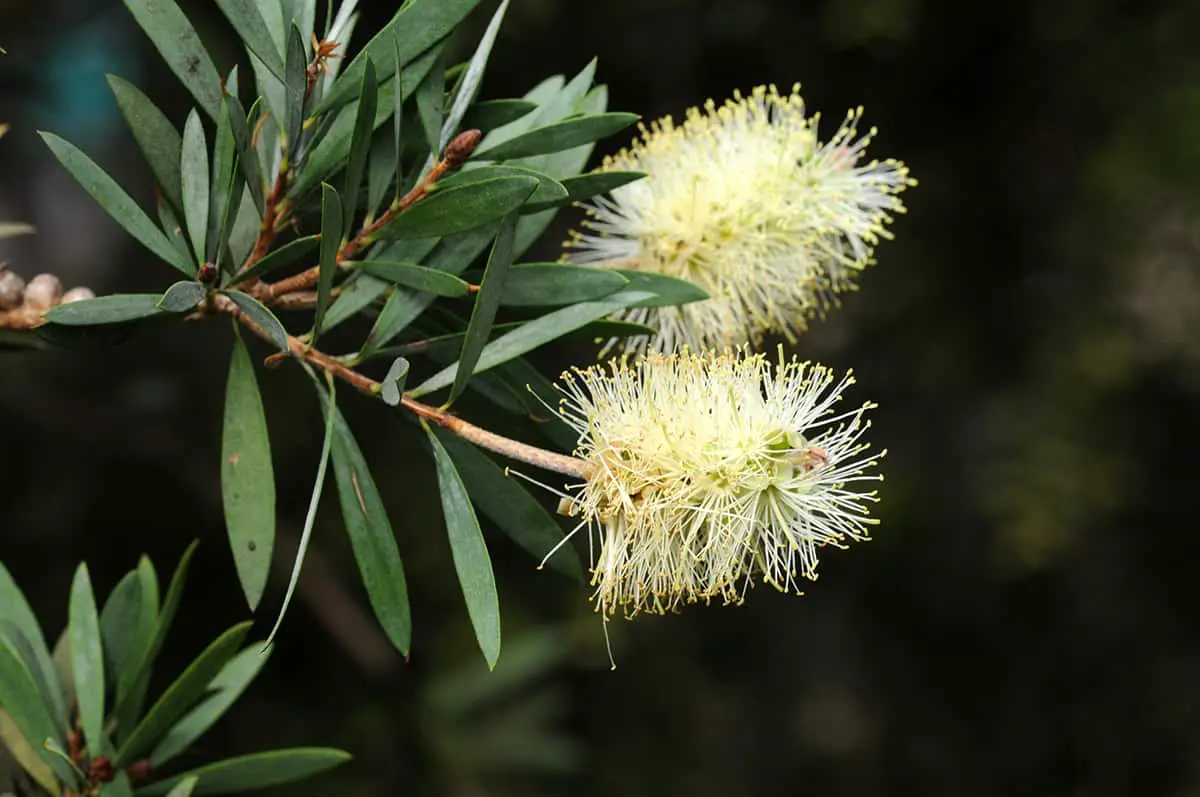
- Botanical name: Callistemon pallidus
- Family: Myrtaceae
- USDA hardiness zones: 10 – 11
- Mature height: Up to 10 feet
- Mature spread: Up to 10 feet
The Lemon Bottlebrush is an evergreen shrub native to Australia. It has a spreading habit, growing as wide as it is tall. The flowers of the plant look like the type of brushes you would use to clean the insides of bottles, hence the common name of bottlebrush. They are white with a slight tinge of yellow and have a soft, fluffy look to them.
The foliage of the plant is gray-green and is covered in downy hair. The plant gives off a sweet citrus scent, making it a pleasant shrub for growing near an outdoor seating area. The spreading nature of the plant means it lends itself well to use as a hedge, but it can also be used as an individual specimen or for borders. It prefers to be grown in acidic, moist soils, in a position of full sun or partial shade.
Tea Plant
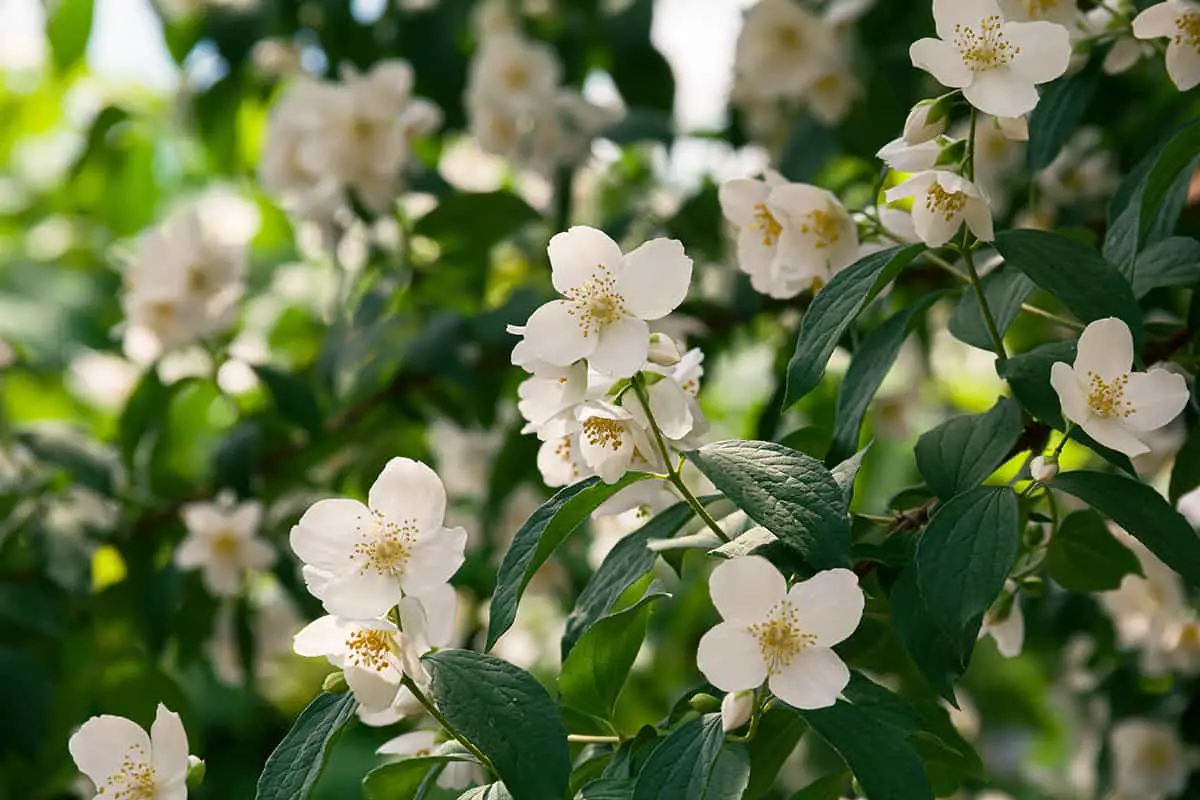
- Botanical name: Camellia sinensis
- Family: Theaceae
- USDA hardiness zones: 7 – 9
- Mature height: Up to 15 feet
- Mature spread: Up to 10 feet
This shrub is native to China, and as you may have guessed from the name, it is this plant’s leaves that are used in the making of tea. It is believed to be the most widely grown type of Camellia across the world due to the popularity of the beverage. The foliage is dark green and leathery, and the leaves are used at various points to make different types of tea.
Young leaves and leaf buds produce green tea, while older and larger leaves are used in the making of black tea. The flowers of this plant are white and fragrant, and will measure between 1 and 2 inches across. Unlike most plants, the blooming period of the Tea Plant occurs during fall and winter, making it a great option for adding winter flowers to the landscape at a time when few other species are in bloom.
The Tea Plant thrives in partial shade and should be grown in soil that is moisture retentive yet well-draining. It has a shallow root system and will benefit from the protection and insulation that mulching provides.
Mexican Orange Blossom
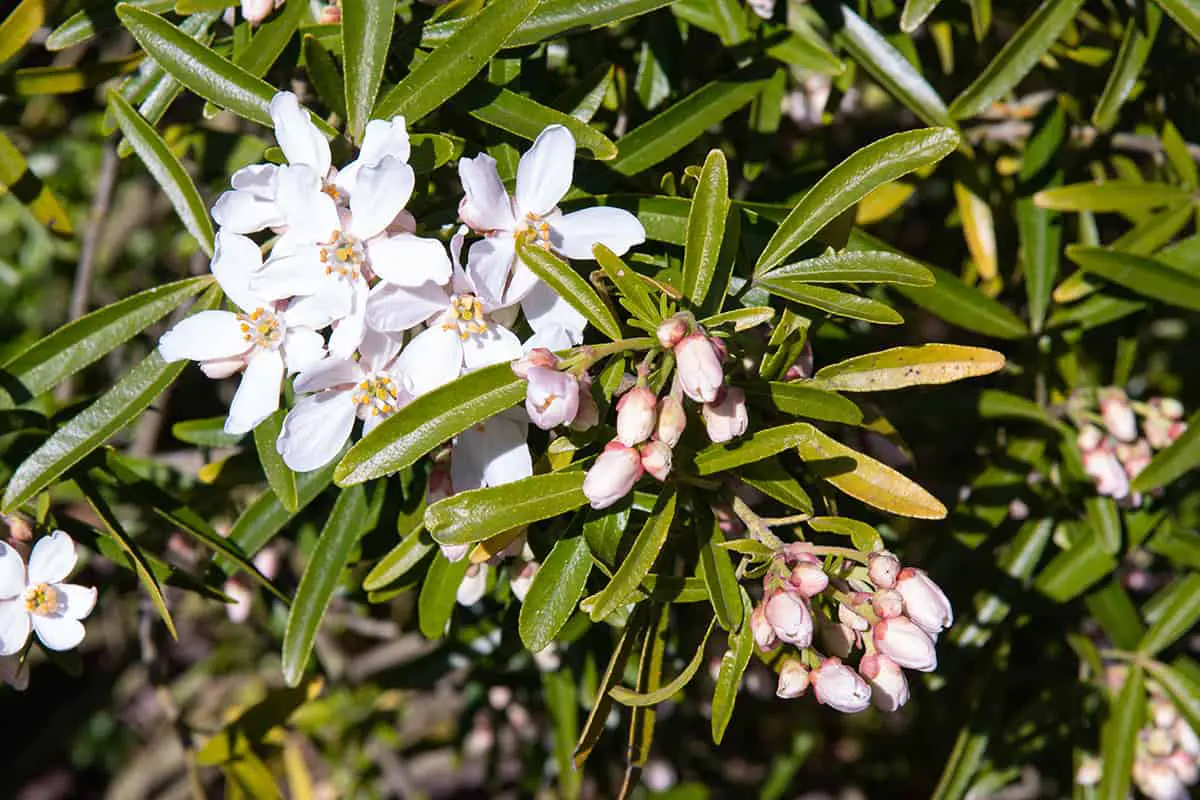
- Botanical name: Choisya ternata
- Family: Rutaceae
- USDA hardiness zones: 8 – 10
- Mature height: Up to 10 feet
- Mature spread: Up to 10 feet
This is an evergreen shrub that is native to Mexico and some of the southwestern United States. It has a dense, rounded habit and is covered with shiny green leaves. In late spring, star-shaped white flowers appear, emitting the heady scent of orange blossoms.
These blooms hang around for just a few weeks until early summer, but the plant can spontaneously bloom again through the summer and into fall. It is not just the flowers of the shrub which have a strong aroma, but the leaves also smell intensely of orange blossom, so the scent can be enjoyed all year round.
Grow the Mexican Orange Blossom in full sun, in well-draining soil. The plant is tolerant of drought and works well as hedging or even for container growth.
Dwarf Fothergilla
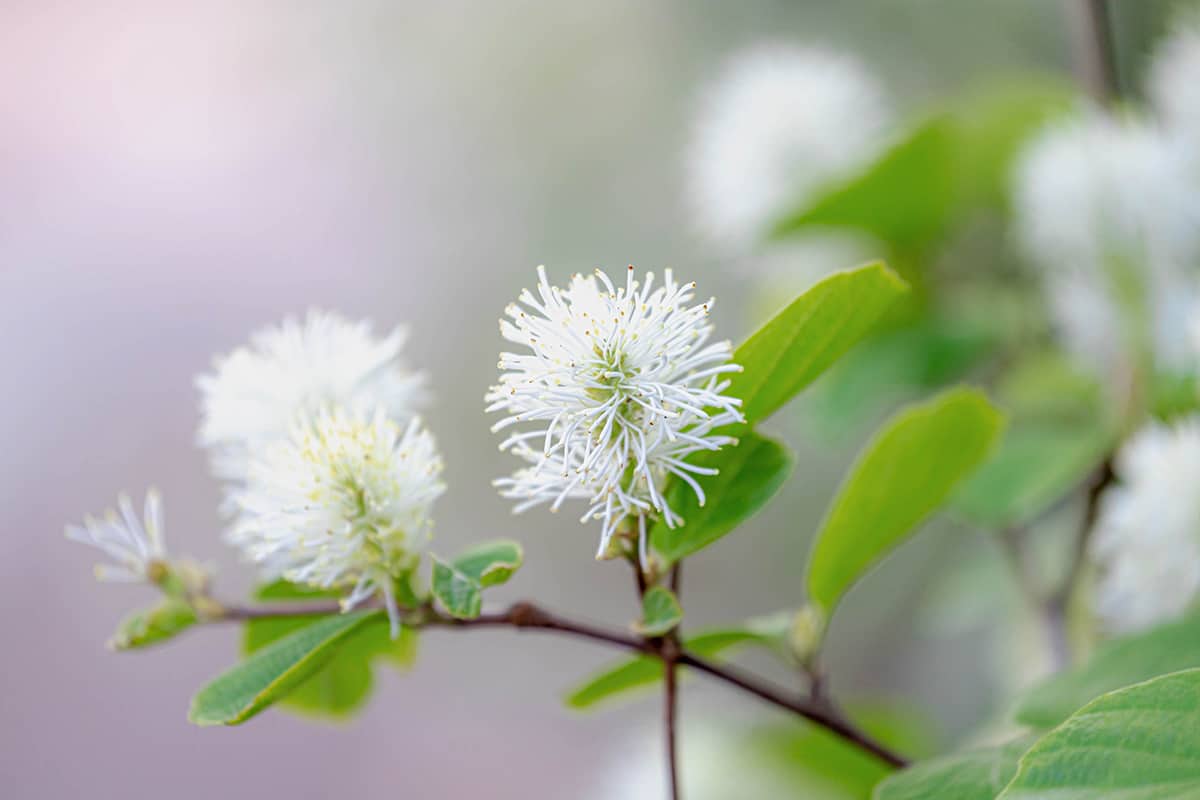
- Botanical name: Fothergilla gardenii
- Family: Hamamelidaceae
- USDA hardiness zones: 5 – 8
- Mature height: 2 to 3 feet
- Mature spread: 2 to 3 feet
This deciduous shrub is also commonly known as Witch Alder, Coastal Fothergilla, and Amazon Wych Hazel. It is native to the southeastern United States, where it is slow growing to an eventual height of up to 3 feet. The plant blooms in spring with a profusion of white bottle-brush-style flowers, which have a rich honey fragrance.
These arrive on bare branches before the emergence of the leaves. The shrub also offers interest from its foliage, which is a deep shade of green-blue in summer, developing to golden tones in the fall before the plant sheds its leaves.
The Dwarf Fothergilla should be grown in well-draining soil, in full sun or partial shade. It prefers acidic soils but will adapt to other soil types. As a low-growing shrub, it works well as a low hedge or border. It can spread via suckers, however, this process is very slow.
Summersweet
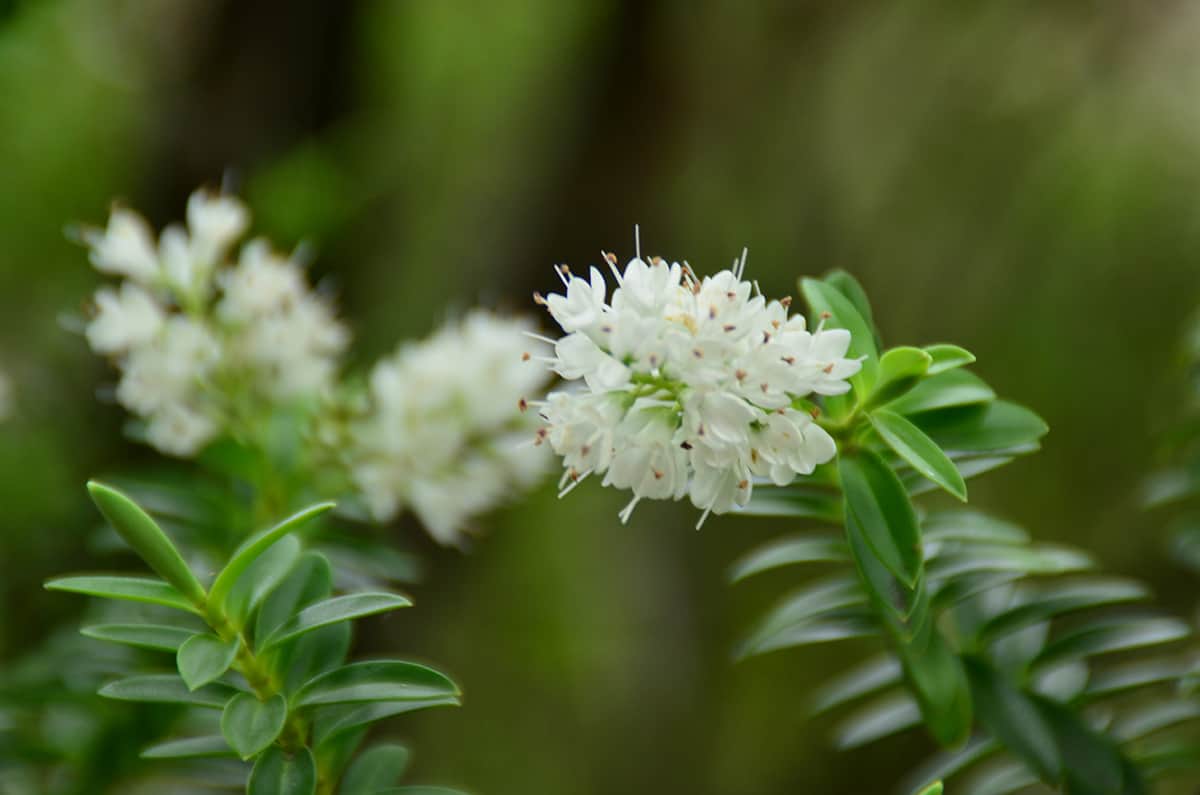
- Botanical name: Clethra alnifolia
- Family: Clethraceae
- USDA hardiness zones: 3 – 9
- Mature height: Up to 8 feet
- Mature spread: Up to 6 feet
This attractive deciduous shrub is also commonly known as the Coastal Sweetpepper Bush. It is native to eastern North America, from Florida in the United States up to Nova Scotia in Canada, and is typically found in swampy conditions.
It has a long blooming period of 5 or 6 weeks from the middle of summer and into fall, during which time the white bottle-brush style flowers emit a strong fragrance. The flowers stand erect at the end of vertical stems and attract a wide range of pollinators at a time of the season when few other flowers remain. The spoon-shaped foliage is a fresh shade of green, and this fades to yellow in fall before the leaves drop.
Summersweet is a reliable shrub that will perform well in conditions that many other plants cannot tolerate. It prefers full sun or partial shade but will still bloom even when grown in full shade. The plant should ideally be kept in moist soils, but it will not be negatively affected even by wet soils. It works well as a wildflower garden shrub, a shade plant, or as a specimen plant next to a pond or stream.
Sweet Bay Magnolia
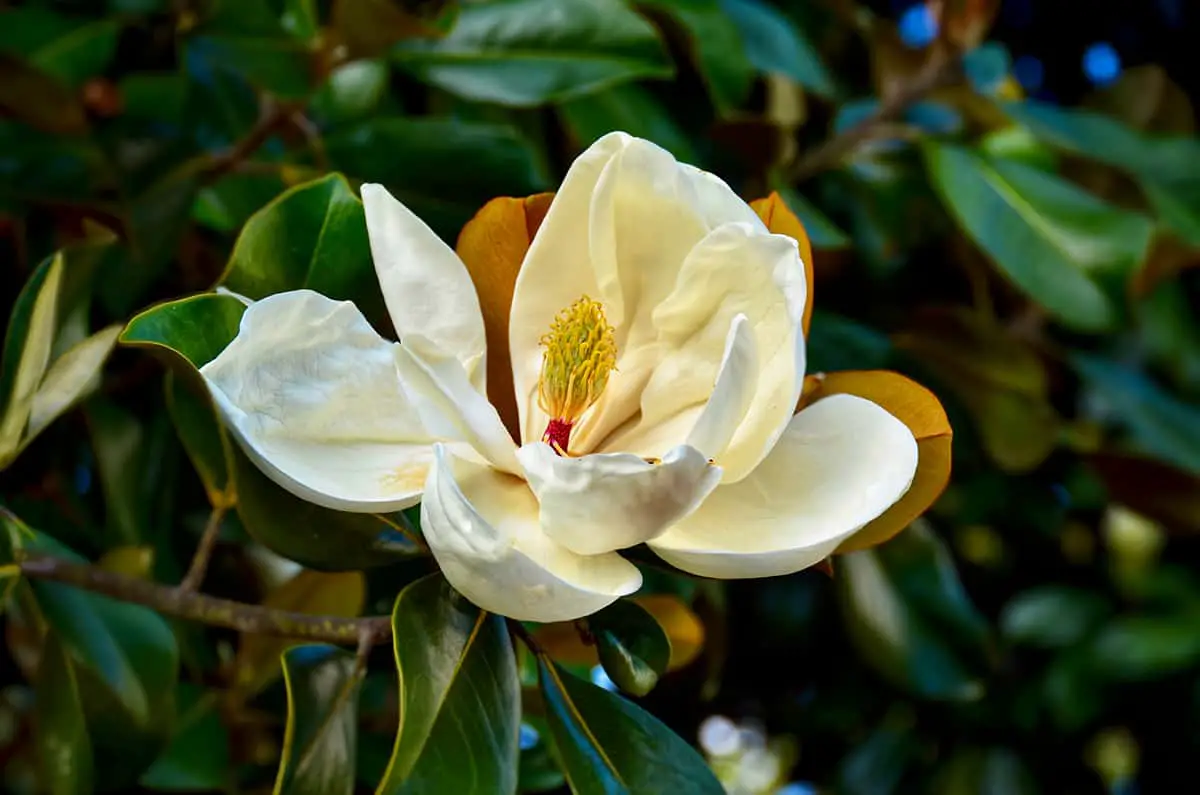
- Botanical name: Magnolia virginiana
- Family: Magnoliaceae
- USDA hardiness zones: 5 – 10
- Mature height: 10 to 35 feet
- Mature spread: 10 to 35 feet
The Sweet Bay Magnolia is native to the southeastern United States and can be grown as a shrub or a small tree. It is evergreen or semi-evergreen, depending on the climate, and produces the beautiful white flowers that Magnolias are known for. The flowers are shaped like cups and give off a delicate lemony fragrance.
They first appear in spring and will continue to bloom throughout the summer months. The soft flowers measure around 3 inches across, which is quite small compared to many other types of Magnolia. They will open up during the morning, and close again overnight. By fall, the flowers will have been replaced by glossy red seeds attached to cones.
The Sweet Bay Magnolia thrives in full sun or partial shade, and unlike many other Magnolia plants, it can tolerate wet soils. It is stunning as an individual specimen and can also work well as hedging or borders.
Cape Jasmine
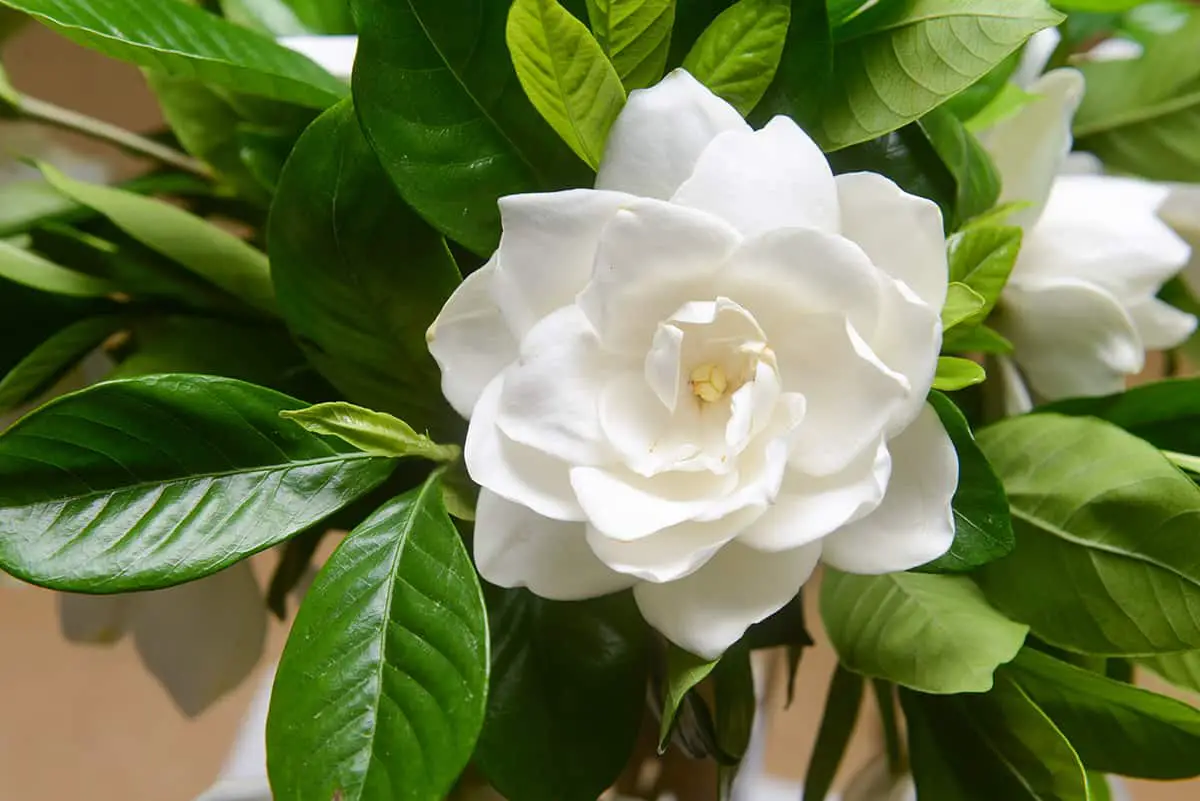
- Botanical name: Gardenia jasminoides
- Family: Rubiaceae
- USDA hardiness zones: 8 – 11
- Mature height: 3 to 6 feet
- Mature spread: 3 to 6 feet
Cape Jasmine belongs to the coffee family of plants and actually isn’t related to true jasmine at all. It is a type of Gardenia and often simply goes by the common name of Gardenia or False Jasmine. It is an evergreen shrub that is native to Asia, producing large, leathery green leaves which retain their color all year round. The flowers are white and measure around 3 inches across.
They are well known for being heavily fragranced with a sweet scent and are particularly pungent in the evening. In warm climates, the Cape Jasmine can bloom all year long, while in cooler regions, it will bloom towards the end of spring and into summer.
Cape Jasmine thrives in full sun in cooler climates and partial shade in hot climates. All parts of the plant are toxic to pets.
Common Jasmine
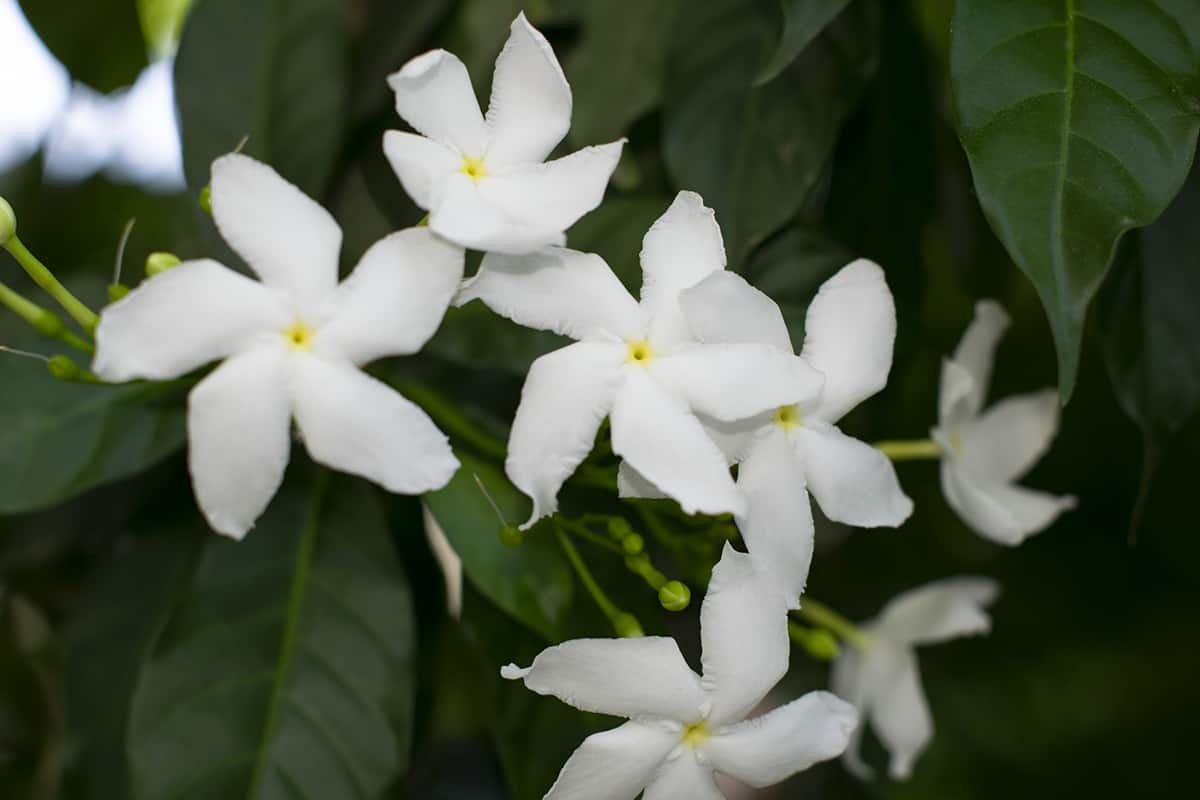
- Botanical name: Jasminum officinale
- Family: Oleaceae
- USDA hardiness zones: 7 – 10
- Mature height: 15 to 30 feet
- Mature spread: 6 to 15 feet
Common Jasmine is famed for its beautifully fragrant, white, star shaped flowers, which appear in dainty clusters on the deciduous climbing shrub. Known as a prolific bloomer, the Common Jasmine will typically remain in flower from late spring right through to the first frost in fall. Jasmine is a fast grower with a vigorous habit, which can reach heights of up to 30 feet.
This plant performs best in a sheltered location, for example, next to a wall or fence, and in well-draining soils. It thrives in full sun to partial shade and works well as a climbing vine, a trailing container plant, or an informal shrub.
